Activity IDs are used in Primavera P6 to uniquely identify an Activity within project schedules. No two activities can have the same ID in a particular project. Primavera P6 allows users to assign a prefix and a suffix with increments in the suffix for the next activity added. A P6 User can assign any type of prefix or suffix to an Activity. Even though this is the case, Activity IDs can be used to add value and can create more unified data output in projects. Activity IDs can be created to uniquely represent project phases, milestones, activity types, or whatever information is most important to track for a particular project. Building intelligence into the Activity ID is valuable and can ensure the project team is following standards. This Tech Tip will show P6 users the different ways in which Activity IDs can be used to the P6 user’s advantage
Defaults for New Activities
Primavera P6 provides users with default settings when adding new activities on the Project level > Project details > Defaults tab. This tool provides ease when adding new activities to the project schedule if there is a standardized Activity ID process that needs to be put in place.
For example, in this project the Defaults for New activities are set to the following:

For each new activity added into the schedule, the P6 User can choose the Prefix and Suffix of the activity and the Increment for the next activity added. This basic auto-numbering feature allows P6
Users to add new Activity IDs with ease instead of manually changing the Prefix and Suffix of the Activity ID. P6 Users should keep in mind this change only affects New Activities added, and not ones that are already in the schedule. So it is best to set this up before adding in New Activities. In this example, Defaults will be changed depending on which WBS the new Activity is being added into.
For example, “MIL” Prefix will be used for new Activities added within the “Milestone” WBS.
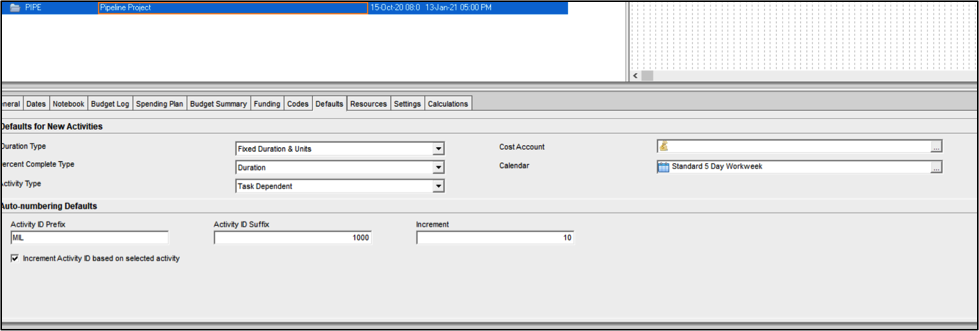
Utilizing Defaults for New Activities
Setting up standardized Defaults for New Activities within a project can benefit the P6 User in many ways. Here we have a new Pipeline Project with (7) different WBS. These are the (7) phases of the project. No activities have been added yet

To ensure a standardized and streamlined process new Activities will be named based on their respective WBS to easily pull reports and data out of the project. When adding new activities to different WBS’s be sure to go back to the defaults on the project level and change it to the Prefix of which everyone has agreed upon for a particular project phase. This will ensure efficiency and accuracy when adding the first activity in the WBS
*Note: The Prefix will only need to be changed upon the first creation of the first activity within its respective WBS because “Increment Activity ID based on selected Activity” is selected
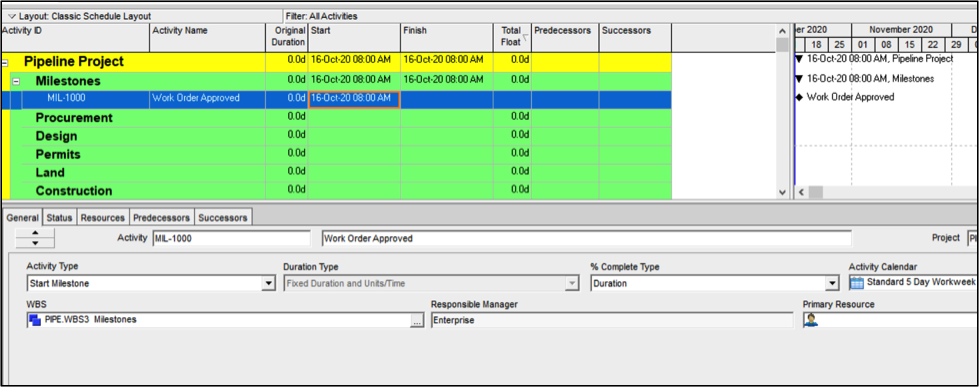
The first activity added has an Activity ID of “MIL-1000” and because at the project level an increment of 10 would be added to each new activity-based onthe highlighted activity the next activity added would be:

Using “MIL” in the activity ID the P6 User can tell immediately that this Activity is a Milestone activity and by adding the activities in which the work should begin can also tell by the increments that Activity ID “MIL-1000” should begin before “MIL-1010”
Now that all new milestone activities have been added into the Milestone WBS it is time to navigate back to the Defaults for New Activities to change the Prefix so it aligns with the Procurement WBS.

The Activity ID Prefix for the Procurement WBS will be “PRO”. Now the first new activity added within the Procurement WBS will be PRO-1000 based off the above defaults. Using the Defaults for New Activities can ensure there are no typos in the Prefix or Suffix to maintain a streamlined Activity ID process. P6 Users can utilize this whenever adding the first new activity in WBS’.
The result will look like below:
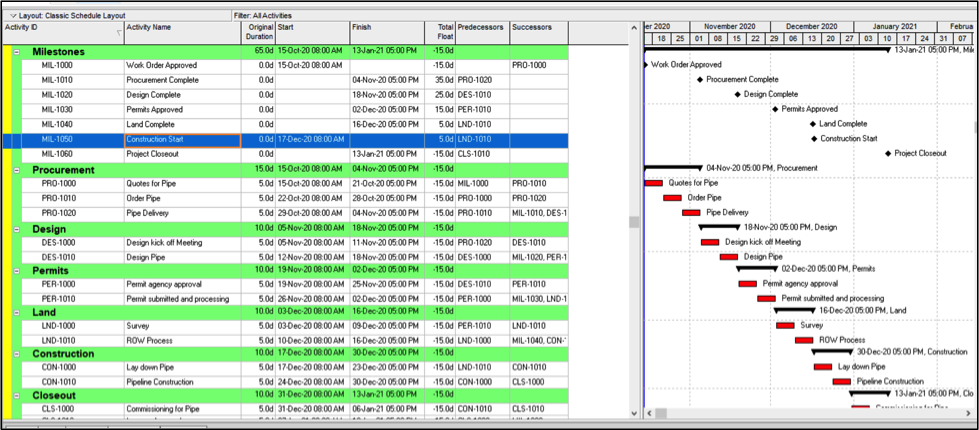
Once logic ties have been made, it is still clear by the Activity IDs which activities are starting and or finishing before other activities within their respective WBS. All Activities with a suffix of 1000 should be the first activities within their WBS to begin work on that activity. It is also clear by the prefix of the Activity IDs to recognize which activities belong to which WBS. This is highly valuable information, especially with Projects that have thousands of activities in them and P6 Users can identify at first glance what phase that Activity is in and the logical ties within the WBS
Retrievable Data by Activity IDS
Once activity IDs are added in with value to a schedule it becomes more efficient for the P6 User to retrieve data within the schedule. For example, if an individual apart of the project team would like to see the first milestone activity in the schedule, based on the Activity IDs created above a P6 User could easily filter the following:
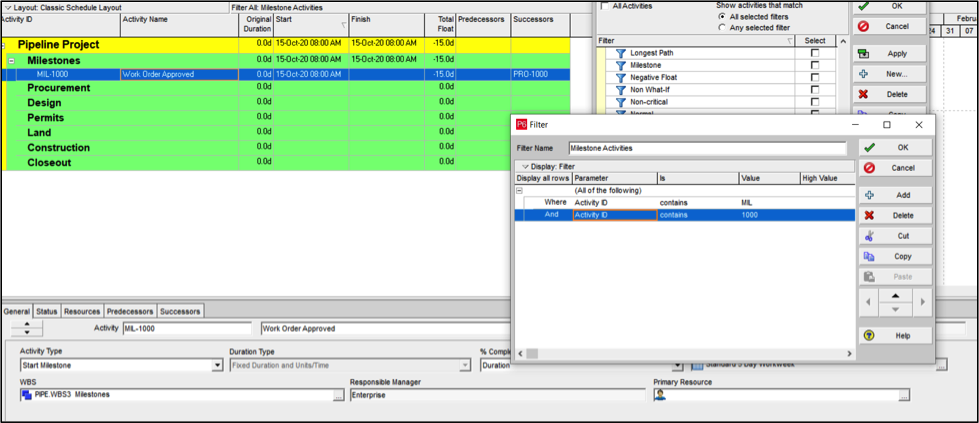
In addition, if an individual would like to see what all the kick-off activities within a project schedule because of the format followed above, one could easily filter the following:
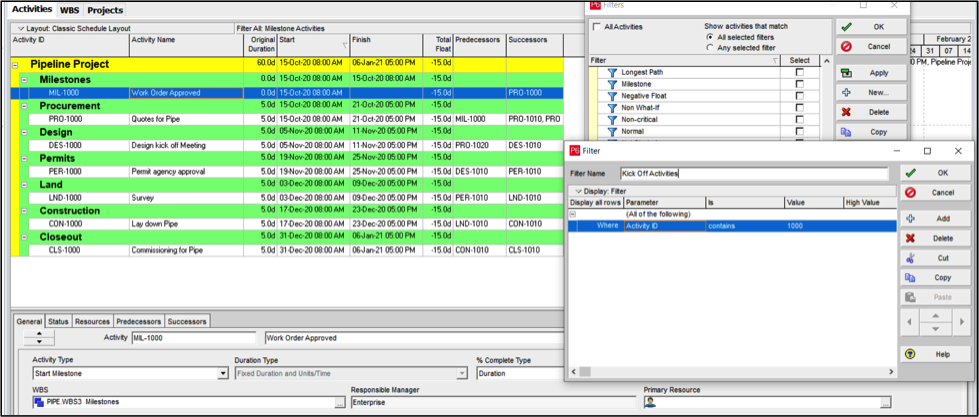
This easily shows what kick-off activities begin first in each WBS and what phase of the project the Activity is in. LOE and WBS Summary activities can also easily be recognized by changing the suffix of an activity to the following:

Creating LOE and WBS as suffix change does not confuse the project team in the Suffix for Milestone and a Task-Dependent activities so a P6 User can still easily recognize that anything ending in LOE or WBS is not task dependent or a Milestone activity. But one can still tell by the Prefix what project phase that LOE/WBS is a part of
Filters can easily pull information from the Activity ID to find both WBS and LOE activities:

Renumbering Existing Activities
If a project has already started and there is no formatting to Activity IDs a P6 User can utilize the Renumber Activity IDs feature that Primavera P6 offers. For example, this cost account project was created with no value or intelligence to the Activity IDs:
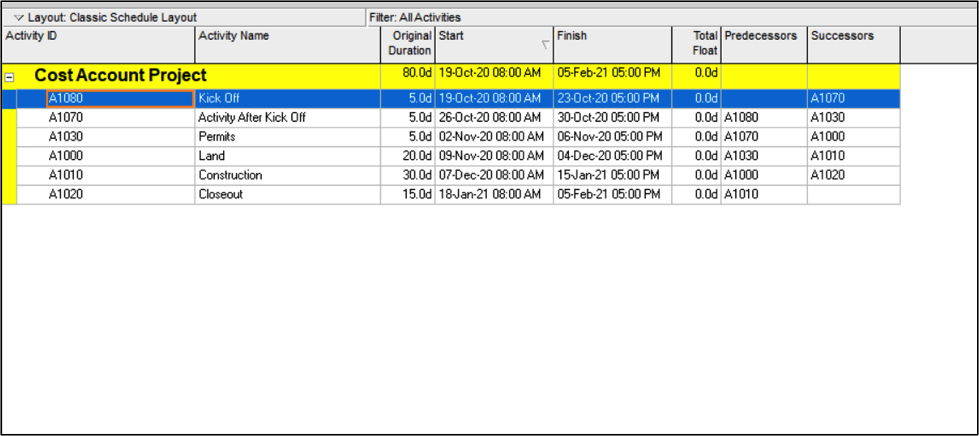
There is no way of telling which activity is supposed to logically begin before another or what Phase these activities belong to
Highlight the order in which activities are logically linked. And choose a prefix, suffix, and increment value
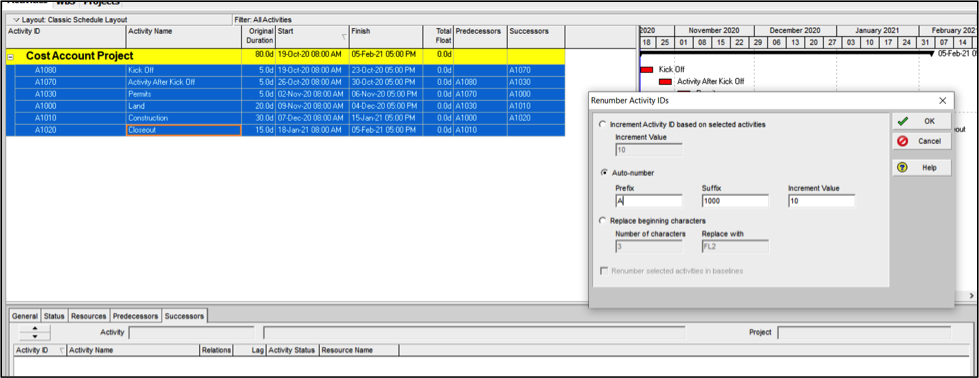

Now the suffixes of the activities are in order in which the activities are logically linked.
Conclusion
Activity IDs are an important piece in building a standardized and organized project. It can ensure that everyone involved with the project is talking about the same Activity and on the same page. In addition, it can let a P6 User know which phase the Activity belongs to and where it is at within the WBS. Having unique activity IDs can also allow a P6 User to easily find a given activity and create reports for specific Activities.
